What does it take to outdo the Prius at hybridness?
Hyundai – and the Ioniq hybrid.
By just about every metric other than who got there first, the Hyundai is the pick of the litter. It costs less – and it uses less gas. It is roomier – both for people and cargo – but it’s not as big as the Prius.
And it’s much quicker.
You can also get it as a standard hybrid, a plug-in hybrid and a full-monte electric car. The Prius comes in only two of those three ways.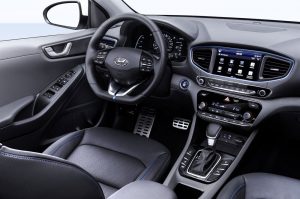
The Hyundai also comes standard with almost twice the warranty coverage – five years and 60,000 miles vs. three years and 36,000 miles on Toyota.
WHAT IT IS
Like the Prius, the Ioniq is a compact-sized, five-door hatchback hybrid.
Also like the Prius, it isn’t just a hybrid.
There is no “regular” (non-hybrid version) of either the Ioniq or the Prius; these come only as hybrids, were designed from the wheels up to be hybrids. Put another way, they weren’t converted into hybrids after the fact, as were most of the other hybrids on the market – including models like like the hybrid versions of the Ford Fusion and the Toyota Camry and the Chrysler Pacifica minivan.
Not that there’s anything wrong with that.
But dedicated hybrids are lighter and more aerodynamically efficient than converted hybrids. Which is why both the Prius and the Ioniq are 10-15 MPG more fuel-efficient than all of the converted hybrids on the market.
Converted hybrids are also usually functionally impaired by tiny trunks – some less than 10 cubic feet – because there was nowhere else to put the batteries, after the fact.
They have to put the batteries somewhere in the Prius and Ioniq, too. But because they were designed from the wheels up to be hybrids, space for the batteries was designed in – leaving plenty of cargo space.
About twice as much space (26.5 cubic feet in the Ioniq) as most mid-sized non-hybrid sedans – and nearly three times as much space as some converted hybrid sedans.
But where the Ioniq parts ways with the Prius begins with its price. You can pick one up for $22,200 – the MSRP of the entry-level Blue trim – vs. $23,475 for the least expensive version of the Prius.
The gap continues to widen – at the pump.
EPA says 57 city, 59 highway for the Hyundai hybrid vs. 54 city and just 50 on the highway for the Prius, a difference of 9 miles per gallon.
Another gap is discernible in the back seat. The Ioniq has 35.7 inches of legroom vs. 33.4 inches in the Prius. And behind its back seat, the Ioniq has more cargo room, too: 26.5 cubic feet vs. 24.6 cubic feet.
As OJ used to say – look out!
WHAT’S NEW
The 2019 Ioniq is available with a drowsy driver alert system and automatic high beams, automated emergency braking and adaptive cruise control (SEL trims).
The plug-in and all-electric versions (reviewed separately) now come with remote charge monitoring; you can connect with the car via an app on your phone to check on the state of the battery’s charge – without having to physically go have a look at the car.
Makes economic and functional sense . . . and it’s fun.
Makes more sense than the Prius – which costs almost $1,300 more to start, isn’t as roomy for people or cargo, is significantly less fuel efficient . . . and much slower.
Doesn’t look weird – or drive weird.
Unbeatable warranty coverage.
Rear glass is almost horizontal – hybrid under glass! – resulting in a skewed view to the rear.
If you want people to know you’re driving a hybrid, they won’t.
Prius is still has the bluer chip (and Al Gorean) rep.
Kia Niro hybrid – the Ioniq’s brother from the same mother – has even more room.
UNDER THE HOOD
The Ioniq is the most fuel-efficient hybrid you can buy. And it isn’t slow.
A Prius – which is less fuel-efficient – takes a pretty palsied 10.5 seconds to get to 60 vs. 8.9 seconds for the Ioniq.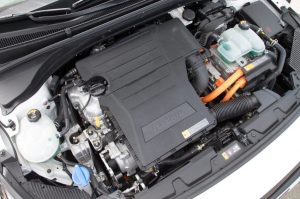
Both cars weigh about the same – 3,031 lbs. for the Ioniq vs. 3,075 lbs. for the Prius – but the Ioniq has a lot more power. The combined output of its 1.6 liter gas engine (104 hp) and 44.5 kW electric motor (60 hp) is 164 hp – 43 more horsepower than the combined output (121 hp) generated by the Toyota hybrid’s gas-electric powertrain.
Of course, quickness isn’t why most people buy a hybrid; gas mileage is.
The Prius used to be the king of the fuel efficient – but it’s not anymore.
Perhaps because the Ioniq has power to spare – while the Prius has just barely enough – the Hyundai uses a lot less gas than the Prius. Particularly on the highway – where it scored 9 MPG better than the Prius on the EPA’s test loop: 59 vs. 50 MPG.
The two are closer in city driving – 57 MPG for the Ioniq vs. 54 for the Prius – but the Hyundai’s average (city and highway) is almost 60 MPG while the Toyota’s is closer to 50 – because it gets dragged down by its not-so-great highway number.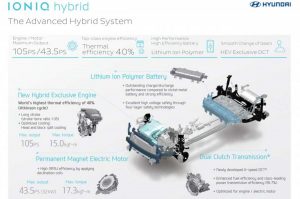
And you get to 60 almost 2 seconds sooner in the Ioniq – a big difference.
Another difference between the two is that the Ioniq does not have a continuously variable (CVT) automatic transmission – which most other hybrids (including the Prius) do have. CVTs are an efficiency boon because they are always in the right “gear.”
Because there are no gears inside a CVT.
Instead, the CVT continuously varies the mechanical ratio (via variable diameter pulleys and a belt connecting them) to keep the engine operating at the most efficient spot in its powerband without stepping up (or down) from one gear to the next. And the ratio can be varied almost infinitely, whereas a geared manual or automatic transmission shifts up (and down) through a fixed number of forward speeds, each gear being close to the right ratio for a given road speed and load – but not as close as the CVT’s infinitely variable ratios.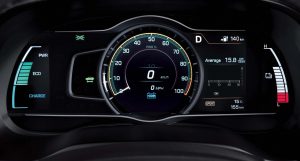
But CVTs can be noisy – accentuating the noises made by an underpowered engine that doesn’t make much power until it’s revved way high in the powerband.
You floor it, the engine screams up the tach, often right up to near redline – and will stay near redline until you back off the accelerator pedal.
A transmission with fixed (e.g., 1-6) gears will upshift through the gears, engine RPM decreasing as the transmission moves up to the next highest gear, reducing engine noise as you accelerate.
The Ioniq has that kind of transmission.
It is a six-speed automated manual transmission – which combines the efficiency advantage of a manual transmission with the programmable shift perfection of an automatic. These transmissions are nearly as efficient as CVTs – but without the noise or the weird (to some) turbine-like operating characteristics of a CVT.
They are also much better for performance. You’ll find them in many current high-powered sports cars and sport sedans.
The Ioniq is the only hybrid that has one.
Well, not counting its Kia-badged sibling, the Niro.
When the Prius was new back in ’98, it was like nothing else – and Toyota played that up.
The original Prius looked different – and it drove differently.
Like a . . . hybrid.
It not only made no engine noise when the gas engine wasn’t running, it made different noises when it was. The turbine-like whirring of the CVT transmission, for one. The beeps it made (and still does) when you backed it up, for two.
And the Prius felt different, too.
There was’t a conventional gear selector. There was – still is – an odd little toggle thing. It’s mounted on the lower lip of the dashboard. Which is laid out in a very I’m a hybrid manner. All LCD displays, all centrally mounted.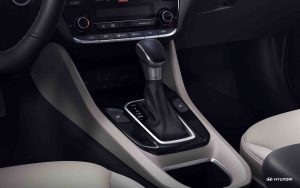
Nothing in front of the steering wheel except dashboard.
You can’t be a passenger in the Prius and not be aware that you’re in a hybrid. Everyone else knows it, too. Which has its downsides.
Just as Subaru Foresters somehow became associated with alternate lifestyles, the Prius became the car of choice not just for people trying to save money on gas but also people determined to make sure everyone was very aware of their interest in all things Al Gorean.
Which carries with it certain . . . associations that not everyone wants to be associated with.
No one will know you’re driving a hybrid – including your passengers – unless you point it out to them. This means you’re less apt to get cut off by some dude in a jacked-up 4×4 who would cut off a Prius, just to spite the presumed Al Gorean within.
In the Ioniq, you are anonymous.
You’ll also be able to do things you couldn’t in a Prius. Or at least, do them with greater ease – because you’ve got more margin. Two seconds’ difference to 60 is a very big deal when you need to achieve merging speed right now with traffic running 70 that isn’t going to slow down to accommodate you.
Especially if they think you are an Al Gorean.
Having more than enough power – as opposed to barely enough – also means you can make a hole, if need be.
The dick in the jacked-up 4×4 notwithstanding.
The conventional gear selector is mounted on the center console.
Though it’s drive by wire a much as any new car’s gear selector (meaning, the lever isn’t physically connected to the transmission via a cable) it feels more connected than the Prius’ game boy toggle – which imparts almost no feel at all.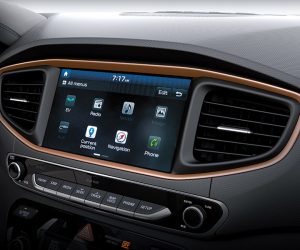
There is also no regenerative braking position – just Park, Reverse, Neutral and Drive and Sport mode (engaged by moving the lever to the left). The hybrid operation is handled more automatically than in the Prius, though you can watch the proceedings – as in the Prius – by a display that can be called up on the LCD screen in the center stack.
The Ioniq also accelerates more conventionally. More quietly – as well as quickly. The six-speed automated manual shifts . . . normally. One through six. No redline scream and turbine whine. The interplay between gas engine off and gas engine on is more seamless for this reason. The Prius feels – and sounds – more like an electric car, while the Ioniq feels and sounds like any other car.
One that also gets almost 10 MPG more on the highway than the Prius and easily 10-15 MPG more than just about anything else on four wheels..
When Toyota updated the Prius last year, it doubled-down on the visuals. Now it not only looks like a hybrid, it looks like an angry one.
Too bad it can’t back that up.
The Ioniq is much less visually aggressive.
Other than its very fast (almost flat) back and nearly horizontal rear glass, it looks like most other compact hatchback sedans. It’s beauty lies inside – where you’ll find two-inches-plus more backseat legroom than in the Prius (35.7 inches vs. 33.4 inches) as well as a cargo area (26.5 cubic feet) that is almost twice as spacious as the trunk of any current mid-sized sedan.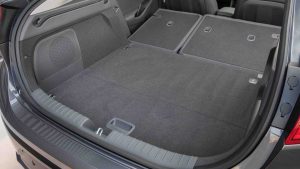
And – more icing! – the Ioniq has a smaller footprint than the Prius. It is 176 inches long vs. 178.7 for the less-space-efficient Toyota.
The almost three inches may not seem like much while reading this, but it will seem like more when you’re driving or trying to park the Prius. Especially in your garage. Close the garage door behind you and see how much those three inches matter when you try to walk between the closed door and the backside of the car.
Space-efficiency-wise, the Ioniq is only outdone by its Kia-badged sibling, which is basically the same package in a different wrapper.
The Niro is shaped like a small crossover SUV and so it has a taller roofline and more cargo space (54.5 cubic feet) as well as an incredible (for its size) 37.4 cubic inches of rearseat legroom.
But the Niro’s not as fuel-efficient (51 city, 46 on the highway) because of the additional weight and less-favorable aerodynamics of the crossover SUV layout.
Its price is higher, too: $23,340 to start.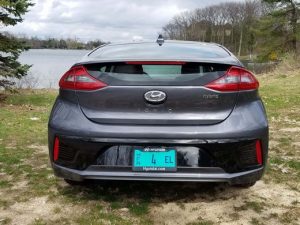
THE REST
The Ioniq’s almost flat rear glass is a mixed blessing. On the upside, it allows for that comparatively huge cargo space under the glass. This little car can cart around more stuff than most big cars. But the near-flat glass (and the big brace in between the glass) gimps the rearward view.
It’s not terrible – but it’s not great, either.
Other than that, there’s little to not like about this little hybrid, which is arguable the best hybrid on the market because it’s the most sensible hybrid on the market.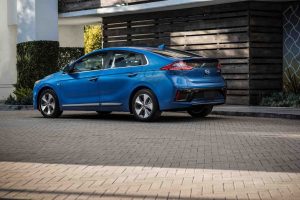
It doesn’t make an issue of itself – or of you. But it does save you money, both up front and down the road.
That it does both of those things without costing you speed or room or any other thing is something that deserves praise.
The car’s main problem is that not many people know about it Hyundai hasn’t done a very good job of marketing it – or the Niro (reviewed here). They ought to pour the coals to this one, because it’s a winner.
THE BOTTOM LINE
For the first time since ’98, the Prius is no longer the pick of the hybrid litter.
. . .
Got a question about cars – or anything else? Click on the “ask Eric” link and send ’em in!
If you like what you’ve found here, please consider supporting EPautos.
We depend on you to keep the wheels turning!
Our donate button is here.
If you prefer not to use PayPal, our mailing address is:
EPautos
721 Hummingbird Lane SE
Copper Hill, VA 24079
PS: EPautos magnets are free to those who send in $20 or more. My latest eBook is also available for your favorite price – free! Click here. If you find it useful, consider contributing a couple of bucks! 


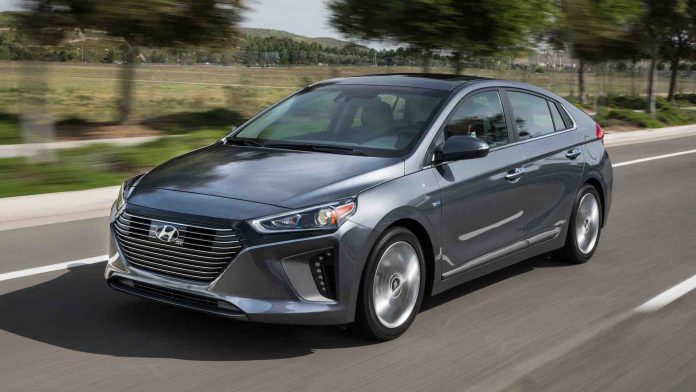

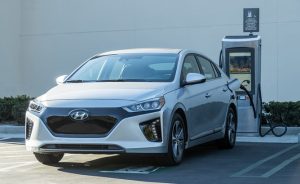

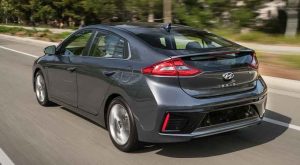
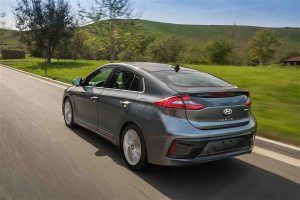

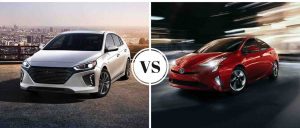








Hyundai is cancelling this. The replacement will be EV only. Guess this hybrid just wasn’t suited for the slavery system the oligarchs are constructing. The Ioniq hybrid provided just too much mobility, too cheaply, too reliably, for the end-user.
What type of car will be more reliable long term: the small turbos like the Chevy Cruze 1.4 turbo, or the Ioniq with its extra batteries?
You criticize the extra complexity involved with the turbo charged cars. But what about in comparison to the extra complexity involved with these hybrids?
Interested in your input and thoughts on this.
Great article, as usual.
A hybrid is something I would have never considered until now, largely based on a shared opinion about the Prius (it seems to have a lot going for it, but it’s just not for me).
Sorry if you’ve already gone over this and I missed it, but is there any solid answer yet as to whether the lifespan of a car that relies on battery power to some degree is compromised by the limitation that batteries have on the number of charging cycles they can endure? Would Minnesota winters possibly make this type of car a poor choice if the idea is to hang onto it for 7-10 years?
I operate a battery powered forklift (we have a fleet of over 50) so I know how problematic they can be, especially when the temp dips below zero. But I would assume given it’s a hybrid having the battery side of things go haywire later in its life wouldn’t necessarily render the car useless. Please correct me if I’m wrong.
Neither here nor there, but speaking of all this EV stuff I never see it mentioned that the chargers also have a lifespan, and they’re not cheap. I would imagine that someone with their own personal unit could get a reasonable amount of use out of it to justify the cost, but if what I see at my job is any indication the ones at the equivalent of a gas station for EVs would probably need to be replaced every few years. They occasionally fry in extreme heat, and often get very buggy in extreme cold. Charging also takes much, much longer in cold conditions.
I work for FedEx and they are fantastic as far as not skimping on getting the best equipment available. In the 8+ years I’ve been there I don’t think I’ve ever seen a “fast” charger last more than three years before hardly working at all, and a few units have destroyed equipment and have even caused fires.
Eric – What is the top speed on this car? Did you manage to open it up? I see the speedometer only goes to 100 mph. Is that true?
I know you dislike the Prius, Eric, but that transmission it has is a work of genius. The Prius doesn’t have a CVT, even though it’s labeled as such. It has a single planetary gearbox, with the gasoline engine connected to the carrier ring, with the bigger electric motor/generator (MG2) turning the outer gear, and the smaller electric motor/generator turning the sun gear. That’s it – no gear ratios, no other gears.
What the car computer does is figure out how much of your net power should come from the gas engine, and how much from the batteries (or go into the batteries). It then sets the gas engine power where it wants, uses the MG2 to add power, or to fight against the engine as a generator. Then, all that MG1 does is rotate the sun gear at a rate that makes the blend of power/generator exactly right. It’s freaking brilliant to this gearhead, but I wish it was available in a cooler car. You could do a lot with this if you combined it with a better gas engine, fun wise. It’s a pretty light, flexible system which doesn’t need a transmission at all, and can very precisely control output shaft power (launch control, traction control without using brakes or cutting ignition).
The “electronic” continuously variable gearing that Toyota uses is a work of a genius and it is also very reliable and durable. Unfortunately it is not very efficient. The automated manual transmission that Hyundai utilizes, is noticeably more energy efficient. Hence the Hyundai Ioniq is also significantly more fuel efficient that the Toyota Prius.
Hi Jone,
I commend Hyundai (and its Kia subsidiary) for doing such a good job with the Ioniq and the Niro – both of which are my picks of the litter when it comes to hybrids, because they’re inexpensive, efficient – and fun!
Coals? For shame!!!
“They ought to pour the coals to this one”
I guess the big question for me would be how much of a premium are you paying for the Ioniq versus a comparable non-hybrid Hyundai? The Elantra might be comparably sized, since it has identical 35.7 inch rear leg room. And at a MSRP of $18k, it is $4k less upfront, and gets about 40 MPG highway. In 100k miles of driving, that’s 2,500 gallons of gas, versus about 1,700 gallons for a 60 MPG Ioniq. 800 gallons of saved gas, times $2.50 a gallon, equals $2,000 in savings.
So around 200K miles of driving to get to the breakeven point? Still not making economic sense.
And at about 8 seconds 0-60, the Elantra is significantly quicker than the Ioniq, which takes about 9 seconds.
So, basically, the main advantage the Ioniq has is in the large cargo space. Which, if you need it, might justify the price and being slower.
Hi Jim,
The gulf is not huge – and after a week of thrashing it, the worst I averaged was 55.3 MPG. That’s easily 15 MPG better than any current gas-only compact sedan/hatch. If I owned this car, I estimate it’d save me about $20-$25 week on gas; so about $1,200 per year. Since I keep cars a long time, the savings would be significant.
And the thing has some balls – which the Prius doesn’t.
The sad thing is we could have 60 MPG without the hybrid, were it not for Uncle… but this is a good as it gets!
Hi Eric,
You must drive your non-testing cars a lot. The math is pretty simple – the savings for 55 MPG average versus the 36 MPG the Elantra should average, give or take, is about a gallon every 100 miles. At $2.50 a gallon, that’s $2,500 in fuel savings in 100,000 miles of driving. You’d have to drive 1,000 miles a week to realize $25 a week in savings.
Breakeven point is around 160,000 miles of driving to recoup the initial $4,000 premium. It makes economic sense for people like you and I who drive the wheels off their cars – or if future gas prices go thru tbe roof. Most people, not so much.
I am hoping my Ioniq will have much better resale/trade value than an Elantra. Coming from a pickup truck it has plenty of power/fun for me. I was seriously considering the ’19 corolla hatch (42 highway), but the cargo space was non-existent and I think I would have had trouble driving it to the rated fuel economy.
Hi Joe,
I suspect it will. For one, Hyundai’s rep is soaring – and not just for reliability. They make interesting and fun cars. The Ioniq being a really good example, especially vs. the Prius … which is the Mrs. Doubtfire of transportation!
This car will probably end up having the same problem that the Chevy Bolt has vs. the Tesla 3. It’s not the Prius and won’t ever be. Just like the Bolt is not the Tesla 3, in spite of probably being the better car.
It’s funny you could run down to the Chevy store and probably get a great deal on a Bolt TODAY, nope, gotta wait for the Tesla 3 no matter how long they make you wait.
It just shows the farce that is the “green” automobile. It’s the supporters of these stupid cars that make it so they are always going to be gimped in some fashion. Just greenwashing. If the Ioniq sits on dealer lots and sells slowly, it will only prove it. They won’t care that the Ioniq runs circles round the Prius.
Though if you do want an Ioniq, maybe there will be some great deals in the fall when they want to clear the lot of them.
Hi Rich,
Yes, I agree… sadly. It’s not the merits that matter; it’s the image.